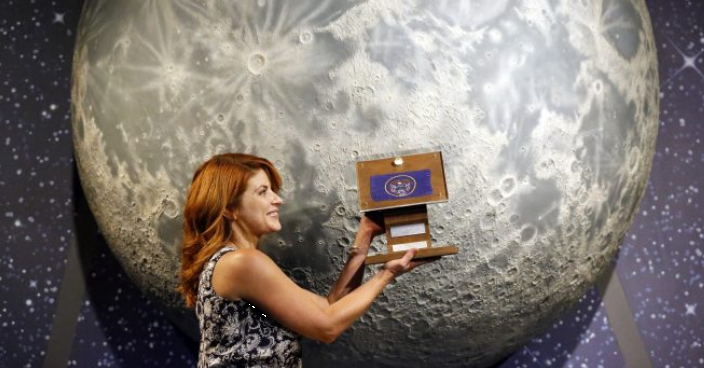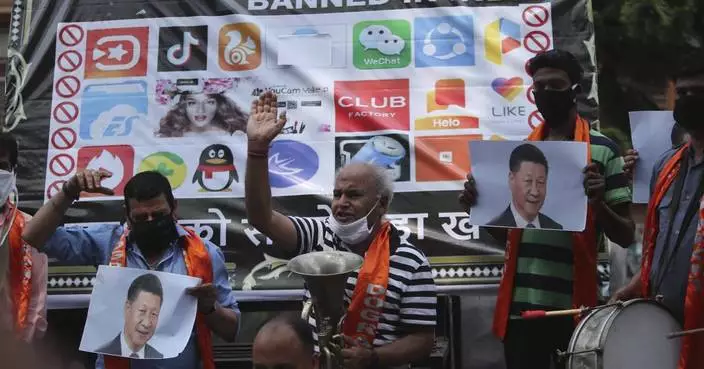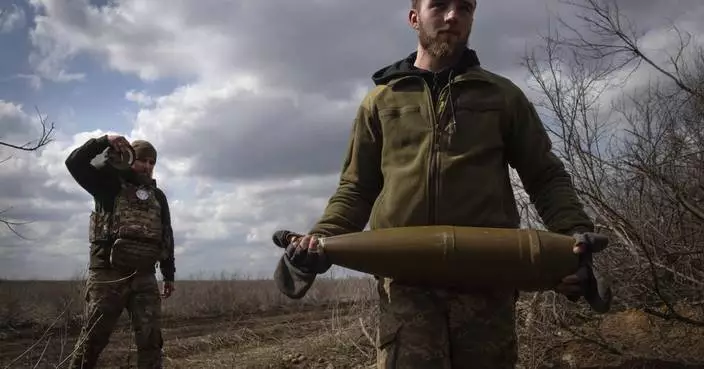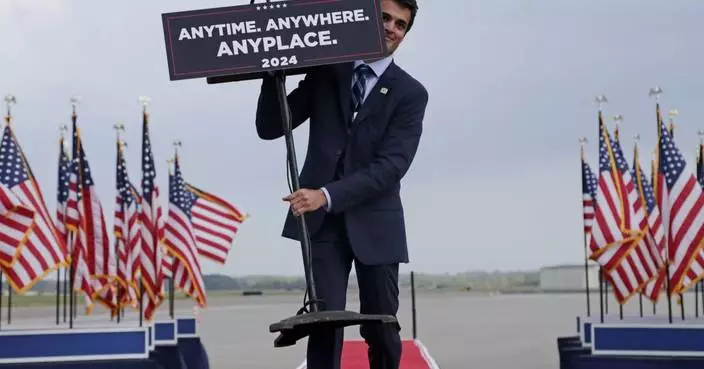A strange thing happened after Neil Armstrong and the Apollo 11 crew returned from the moon with lunar rocks: Many of the mementos given to every U.S. state vanished. Now, after years of sleuthing, a former NASA investigator is closing in on his goal of locating the whereabouts of all 50.
In recent weeks, two of the rocks that dropped off the radar after the 1969 mission were located in Louisiana and Utah, leaving only New York and Delaware with unaccounted-for souvenirs.
Attorney and moon rock hunter Joseph Gutheinz says it "blows his mind," that the rocks failed to be carefully chronicled and saved by some of the states that received them, but he is hopeful the last two can be located before the 50th anniversary of the Apollo 11 mission next summer.

In this Wednesday, Aug. 22, 2018, photo, shows moon rocks encased in acrylic and mounted on a wooden plaque at the Clark Planetarium, in Salt Lake City. A former NASA investigator who has spent more than a decade tracking missing moon rocks is closing in on his goal of finding all 50 lunar samples gifted to U.S. states after Neil Armstrong's first steps on the moon. In recent weeks, two more of the moon rocks that dropped off the radar after the 1969 Apollo 11 mission have been located in Louisiana and Utah. (AP Photo/Rick Bowmer)
"It's a tangible piece of history," he said. "Neil Armstrong's first mission ... was to reach down and grab some rocks and dust in case they needed to make an emergency takeoff."
President Richard Nixon's administration presented the tiny lunar samples to all 50 states and 135 countries, but few were officially recorded and most disappeared, Gutheinz said.
Each state got a tiny sample encased in acrylic and mounted on a wooden plaque, along with the state flag. Some were placed in museums, while others went on display in state capitols. But almost no state entered them into an archival record, and many lost track of them, he said.
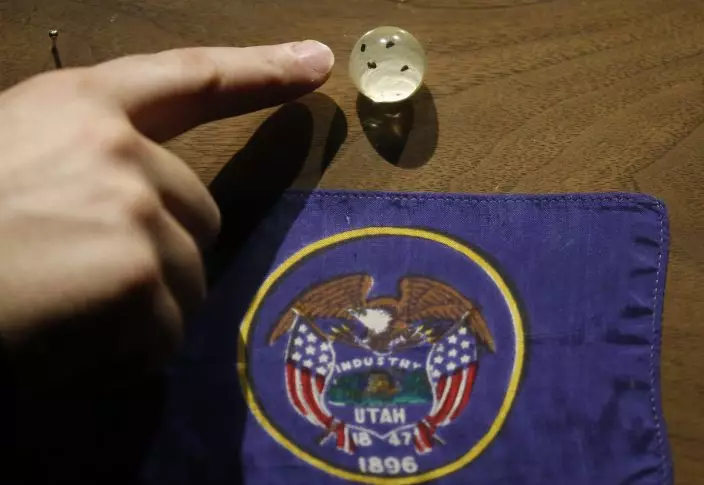
In this Wednesday, Aug. 22, 2018, photo, shows moon rocks encased in acrylic at the Clark Planetarium, in Salt Lake City. A former NASA investigator who has spent more than a decade tracking missing moon rocks is closing in on his goal of finding all 50 lunar samples gifted to U.S. states after Neil Armstrong's first steps on the moon. Each state got a tiny sample encased in acrylic and mounted on a wooden plaque, along with the state flag. (AP PhotoRick Bowmer)
When Gutheinz started leading the effort to find them in 2002, he estimates that 40 states had lost track of the rocks.
"I think part of it was, we honestly believed that going back to the moon was going to be a regular occurrence," Gutheinz said. But there were only five more journeys before the last manned moon landing, Apollo 17, in 1972.
Of the Apollo 11 rocks given to other countries, about 70 percent remain unaccounted for, he said.
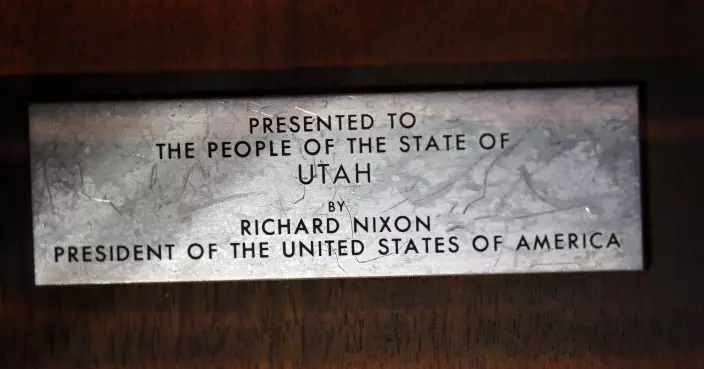
This Wednesday, Aug. 22, 2018, photo shows a plate mounted on a wooden plaque that holds moon rocks encased in acrylic at the Clark Planetarium, in Salt Lake City. A former NASA investigator who has spent more than a decade tracking missing moon rocks is closing in on his goal of finding all 50 lunar samples gifted to U.S. states after Neil Armstrong's first steps on the moon. In recent weeks, two more of the moon rocks that dropped off the radar after the 1969 Apollo 11 mission have been located in Louisiana and Utah. (AP PhotoRick Bowmer)
The U.S. government also sent out a second set of goodwill moon rocks to the states and other nations after the Apollo 17 mission, and many of those are missing too, he said.
NASA didn't track their whereabouts after giving them to the Nixon administration for distribution, said chief historian Bill Barry, but added the space agency would be happy to see them located.
Gutheinz began his career as an investigator for NASA, where he found illicit sellers asking millions for rocks on the black market. Authentic moon rocks are considered national treasures and can't legally be sold in the U.S., he said.
He became aware while at NASA that the gifts to the states were missing, but only began his hunt after leaving the agency.
Now a lawyer in the Houston area, he's also a college instructor who's enlisted the help of his students. The record their findings of the whereabouts of the discovered moon gems in a database.
Many of the Apollo 11 rocks have turned up in some unexpected places: with ex-governors in West Virginia and Colorado, in a military-artifact storage building in Minnesota; and with a former crab boat captain from TV's "Deadliest Catch" in Alaska.
In New York, officials that oversee the state museum have no record of that state's Apollo 11 rock. In Delaware, the sample was stolen from its state museum on Sept. 22, 1977. Police were contacted, but it was never found.
The U.S. Virgin Islands territory, meanwhile, can't confirm that they ever received a goodwill rock, though the University of the Virgin Islands later received Apollo 11 rocks for scientific research, said chief conservator Julio Encarnacion III.
In other states, though Gutheinz has recently hit paydirt. The Advocate newspaper in Baton Rouge located Louisiana's Apollo 11 moon rock in early August after a call from Gutheinz.
In Utah, the division of state history had no record of the sample, but The Associated Press confirmed it was in storage at Salt Lake City's Clark Planetarium.
Officials there may bring it out as part of celebrations recognizing the Apollo 11 anniversary next year, something Gutheinz hopes to see everywhere.
"The people of the world deserve this," he said. "They deserve to see something that our astronauts accomplished and be a part it."
UNITED NATIONS (AP) — Russia on Wednesday vetoed a U.N. resolution sponsored by the United States and Japan calling on all nations to prevent a dangerous nuclear arms race in outer space, calling it “a dirty spectacle” that cherry picks weapons of mass destruction from all other weapons that should also be banned.
The vote in the 15-member Security Council was 13 in favor, Russia opposed and China abstaining.
The resolution would have called on all countries not to develop or deploy nuclear arms or other weapons of mass destruction in space, as banned under a 1967 international treaty that included the U.S. and Russia, and to agree to the need to verify compliance.
U.S. Ambassador Linda Thomas-Greenfield said after the vote that Russian President Vladimir Putin has said Moscow has no intention of deploying nuclear weapons in space.
“Today’s veto begs the question: Why? Why, if you are following the rules, would you not support a resolution that reaffirms them? What could you possibly be hiding,” she asked. “It’s baffling. And it’s a shame.”
Russia’s U.N. Ambassador Vassily Nebenzia dismissed the resolution as “absolutely absurd and politicized,” and said it didn’t go far enough in banning all types of weapons in space.
Russia and China proposed an amendment to the U.S.-Japan draft that would call on all countries, especially those with major space capabilities, “to prevent for all time the placement of weapons in outer space, and the threat of use of force in outer spaces.”
The vote was 7 countries in favor, 7 against, and one abstention and the amendment was defeated because it failed to get the minimum 9 “yes” votes required for adoption.
The U.S. opposed the amendment, and after the vote Nebenzia addressed the U.S. ambassador saying: “We want a ban on the placement of weapons of any kind in outer space, not just WMDs (weapons of mass destruction). But you don’t want that. And let me ask you that very same question. Why?”
He said much of the U.S. and Japan’s actions become clear “if we recall that the U.S. and their allies announced some time ago plans to place weapons … in outer space.”
Nebenzia accused the U.S. of blocking a Russian-Chinese proposal since 2008 for a treaty against putting weapons in outer space.
Thomas-Greenfield accused Russia of undermining global treaties to prevent the spread of nuclear weapons, irresponsibly invoking “dangerous nuclear rhetoric,” walking away from several of its arms control obligations, and refusing to engage “in substantive discussions around arms control or risk reduction.”
She called Wednesday’s vote “a real missed opportunity to rebuild much-needed trust in existing arms control obligations.”
Thomas-Greenfield’s announcement of the resolution on March 18 followed White House confirmation in February that Russia has obtained a “troubling” anti-satellite weapon capability, although such a weapon is not operational yet.
Putin declared later that Moscow has no intention of deploying nuclear weapons in space, claiming that the country has only developed space capabilities similar to those of the U.S.
Thomas-Greenfield said before the vote that the world is just beginning to understand “the catastrophic ramifications of a nuclear explosion in space.”
It could destroy “thousands of satellites operated by countries and companies around the world — and wipe out the vital communications, scientific, meteorological, agricultural, commercial, and national security services we all depend on,” she said.
The defeated draft resolution said “the prevention of an arms race in outer space would avert a grave danger for international peace and security.” It would have urged all countries carrying out activities in exploring and using outer space to comply with international law and the U.N. Charter.
The draft would have affirmed that countries that ratified the 1967 Outer Space Treaty must comply with their obligations not to put in orbit around the Earth “any objects” with weapons of mass destruction, or install them “on celestial bodies, or station such weapons in outer space.”
The treaty, ratified by some 114 countries, including the U.S. and Russia, prohibits the deployment of “nuclear weapons or any other kinds of weapons of mass destruction” in orbit or the stationing of “weapons in outer space in any other manner.”
The draft resolution emphasized “the necessity of further measures, including political commitments and legally binding instruments, with appropriate and effective provisions for verification, to prevent an arms race in outer space in all its aspects.”
It reiterated that the U.N. Conference on Disarmament, based in Geneva, has the primary responsibility to negotiate agreements on preventing an arms race in outer space.
The 65-nation body has achieved few results and has largely devolved into a venue for countries to voice criticism of others’ weapons programs or defend their own. The draft resolution would have urged the conference “to adopt and implement a balanced and comprehensive program of work.”
At the March council meeting where the U.S.-Japan initiative was launched, U.N. Secretary-General António Guterres warned that “geopolitical tensions and mistrust have escalated the risk of nuclear warfare to its highest point in decades.”
He said the movie “Oppenheimer” about Robert Oppenheimer, who directed the U.S. project during World War II that developed the atomic bomb, “brought the harsh reality of nuclear doomsday to vivid life for millions around the world.”
“Humanity cannot survive a sequel to Oppenheimer,” the U.N. chief said.
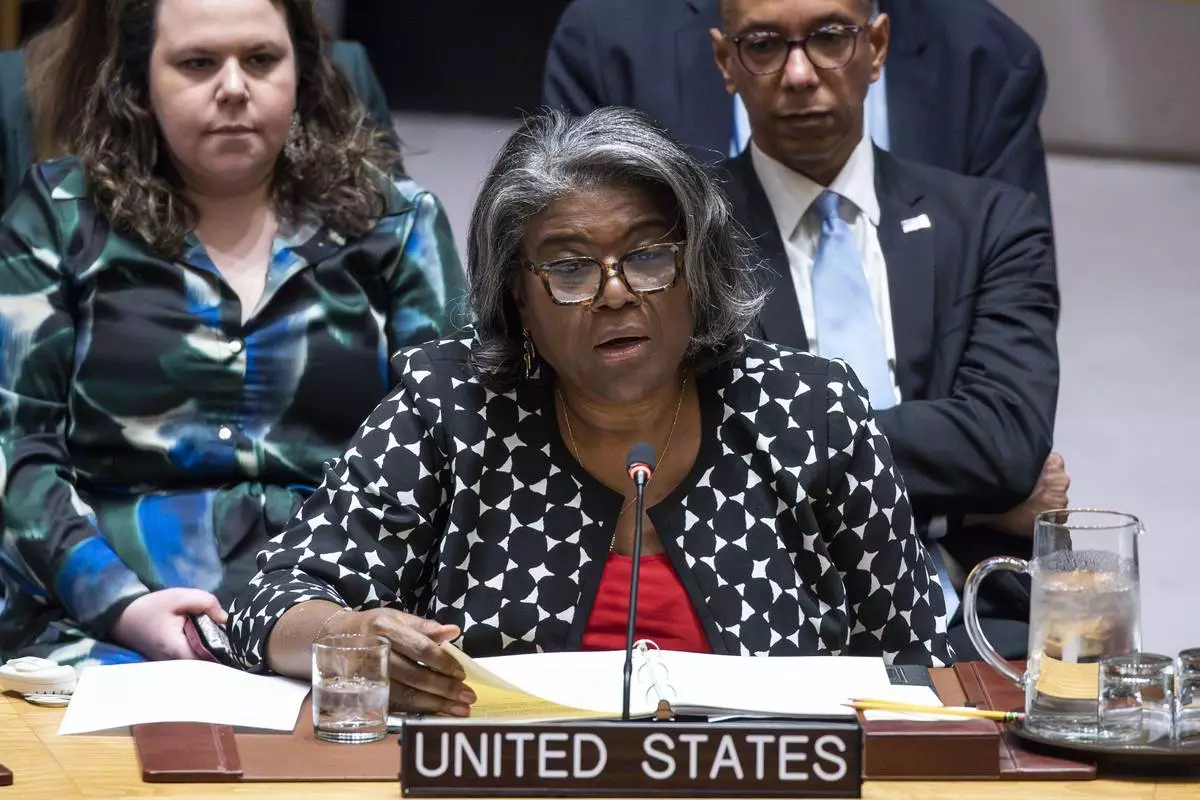
United States Ambassador and Representative to the United Nations Linda Thomas-Greenfield addresses members of the U.N. Security Council before voting during a meeting on Non-proliferation of nuclear weapons, Wednesday, April 24, 2024 at United Nations headquarters. (AP Photo/Eduardo Munoz Alvarez)
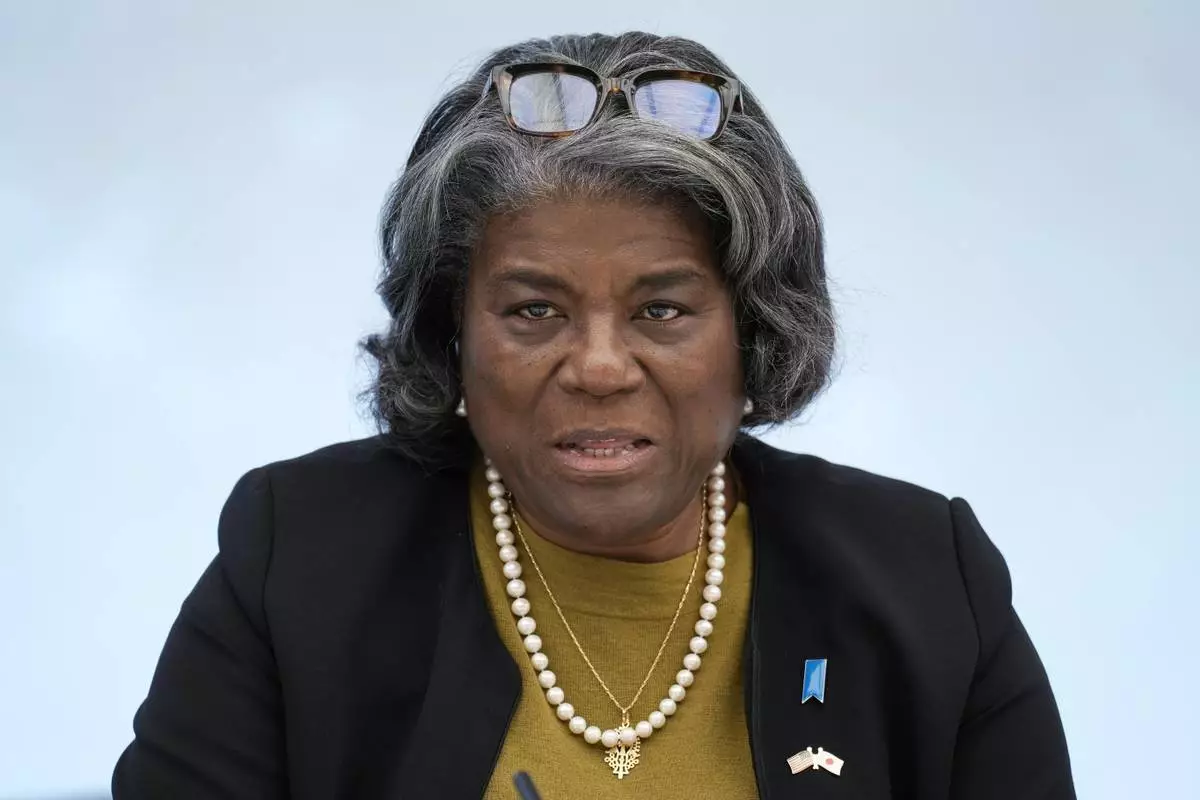
FILE - U.S. Ambassador to United Nations Linda Thomas-Greenfield speaks on Thursday, April 18, 2024, in Tokyo. The U.N. Security Council is set to vote Wednesday, April 24, 2024, on a resolution announced by Thomas-Greenfield, calling on all nations to prevent a dangerous nuclear arms race in outer space. It is likely to be vetoed by Russia. (AP Photo/Eugene Hoshiko, Pool, File)





